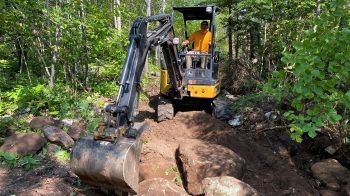My Money Story: The economics of life in a wheelchair
Jay Cramer was rock climbing with friends in Malibu Creek State Park. He had just been chosen as a semi-finalist to appear on the television show “Survivor,” and he wanted to train. He had never been bouldering — free climbing with no ropes — but his friends were experienced.
A 30-minute hike led Cramer to a section of the park that was all water and rock. He took a few harmless falls into the water and got right back up. Then, clinging to the rock, he knew he was going down again. His friend told him to “just let go,” but Cramer pushed off the rock instead.
His head hit rock, he plummeted into the water below. And he couldn’t move, couldn’t flip over. Eyes open, conscious, he looked down into the water. His friends thought he was joking, but when they saw blood, they pulled him out and called for an airlift.
After a long surgery, Cramer woke up in the hospital, paralyzed from the chest down. He shattered his C5 vertebrae, an incomplete injury that left him with feeling, but limited his movement. Fourteen of his friends spent the night in the hospital, and Cramer says when he saw them, he “knew everything was going to be OK.”
“My finances changed when my mobility changed,” Cramer says. “Because there are certain parameters that you have to live by when you need the things that I need.”
Cramer is confined to a power wheelchair. He can drive, and says he’s about 90 percent self-sufficient and leads a very normal life. He needs a caregiver in the mornings “and that can get quite expensive.”
Government-funded programs like In Home Supportive Services give people like Cramer money for a caregiver.
“In order to get that, in order to get Medi-Cal, and anything else that you need, there’s only a certain amount of money you can have in your bank account, and there’s only a certain amount of money that you can make, per month, in order to receive benefits,” Cramer says.
“It’s a very, very fine line that you have to walk, so to speak, to make sure that you’ve got the money that you need to live and survive,” he says. Balancing his own income with state support is tricky, he says.
To make enough money “so that you don’t receive any more benefits and you can be self-sufficient, it’s quite a big jump, because there’s a lot of things that you need to take care of now, medically,” he says.
“I am a very mobile person … because it’s not a ‘when life hands you lemons you made lemonade kind of situation,’ it’s ‘you just want to live your life.’ It doesn’t matter what kind of curveballs are thrown at you,” Cramer said. “The best you can do is learn to adjust and adapt, which oddly enough are two of the important traits that it takes to get you through a game show like ‘Survivor.'”
His life has changed a lot since his accident. He’s found success as an actor and a comedian — the stand-up comedy community rallied around him after he was injured, helping to raise money that he eventually used to buy a car. He also started supervising the Know Barriers peer mentoring program at Rancho Los Amigos Rehabilitation Center.
Cramer also found love. He was single at the time of his accident, but is now married to Katy Sullivan, an athlete who completed in the 2012 London Paralympic Games and a fellow actor.
“You figure it out, you move and you shake, and you make your way through it,” said Cramer, “I honestly see the sky as the only limit, and maybe not even that.”
There’s a lot happening in the world. Through it all, Marketplace is here for you.
You rely on Marketplace to break down the world’s events and tell you how it affects you in a fact-based, approachable way. We rely on your financial support to keep making that possible.
Your donation today powers the independent journalism that you rely on. For just $5/month, you can help sustain Marketplace so we can keep reporting on the things that matter to you.


















